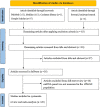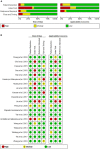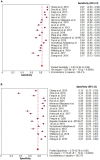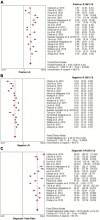MicroRNA panels as diagnostic biomarkers for colorectal cancer: A systematic review and meta-analysis
- PMID: 36419785
- PMCID: PMC9676370
- DOI: 10.3389/fmed.2022.915226
MicroRNA panels as diagnostic biomarkers for colorectal cancer: A systematic review and meta-analysis
Abstract
Background: Circulating microRNAs (miRNA) have emerged as promising diagnostic biomarkers for several diseases, including cancer. However, the diagnostic accuracy of miRNA panels in colorectal cancer (CRC) remains inconsistent and there is still lack of meta-analyses to determine whether miRNA panels can serve as robust biomarkers for CRC diagnosis.
Methods: This study performed a systematic review and meta-analysis to evaluate the clinical utility of miRNA panels as potential biomarkers for the diagnosis of CRC. The investigation systematically searched PubMed, Medline, Web of Science, Cochrane Library, and Google Scholar (21-year span, between 2000 and 2021) to retrieve articles reporting the diagnostic role of miRNA panels in detecting CRC. Diagnostic meta-analysis of miRNA panels used diverse evaluation indicators, including sensitivity, specificity, Positive Likelihood Ratio (PLR), Negative Likelihood Ratio (NLR), Diagnostic Odds Ratio (DOR), and the area under the curve (AUC) values.
Results: Among the 313 articles identified, 20 studies met the inclusion criteria. The pooled estimates of miRNA panels for the diagnosis of CRC were 0.85 (95% CI: 0.84-0.86), 0.79 (95% CI: 0.78-0.80), 4.06 (95% CI: 3.89-4.23), 0.20 (95% CI: 0.19-0.20), 22.50 (95% CI: 20.81-24.32) for sensitivity, specificity, PLR, NLR, and DOR, respectively. Moreover, the summary receiver operating characteristics (SROC) curve revealed an AUC value of 0.915 (95% CI: 0.914-0.916), suggesting an outstanding diagnostic accuracy for overall miRNA panels. Subgroup and meta-regression analyses demonstrated that miRNA panels have the highest diagnostic accuracy within serum samples, rather than in other sample-types - with a sensitivity, specificity, PLR, NLR, DOR, and AUC of 0.87, 0.86, 7.33, 0.13, 55.29, and 0.943, respectively. Sensitivity analysis revealed that DOR values did not differ markedly, which indicates that the meta-analysis had strong reliability. Furthermore, this study demonstrated no proof of publication bias for DOR values analyzed using Egger's regression test (P > 0.05) and funnel plot. Interestingly, miR-15b, miR-21 and miR-31 presented the best diagnostic accuracy values for CRC with sensitivity, specificity, PLR, NLR, DOR, and AUC values of 0.95, 0.94, 17.19, 0.05, 324.81, and 0.948, respectively.
Conclusion: This study's findings indicated that miRNA panels, particularly serum-derived miRNA panels, can serve as powerful and promising biomarkers for early CRC screening.
Systematic review registration: [www.crd.york.ac.uk/prospero], identifier [CRD42021268172].
Keywords: biomarker; colorectal cancer; diagnostic; miRNA; panels.
Copyright © 2022 Sur, Advani and Braithwaite.
Conflict of interest statement
The authors declare that the research was conducted in the absence of any commercial or financial relationships that could be construed as a potential conflict of interest.
Figures






Similar articles
-
Diagnostic Value of Fecal MicroRNAs for Colorectal Cancer: a Meta-Analysis.Clin Lab. 2015;61(12):1845-53. doi: 10.7754/clin.lab.2015.150507. Clin Lab. 2015. PMID: 26882806
-
Detection of microRNA-21 expression as a potential screening biomarker for colorectal cancer: a meta-analysis.Asian Pac J Cancer Prev. 2014;15(18):7583-8. doi: 10.7314/apjcp.2014.15.18.7583. Asian Pac J Cancer Prev. 2014. PMID: 25292032
-
Long noncoding RNAs and circular RNAs as potential diagnostic biomarkers of inflammatory bowel diseases: a systematic review and meta-analysis.Front Immunol. 2024 Mar 8;15:1362437. doi: 10.3389/fimmu.2024.1362437. eCollection 2024. Front Immunol. 2024. PMID: 38524131 Free PMC article.
-
The Diagnostic Power of Circulating miR-1246 in Screening Cancer: An Updated Meta-analysis.Oxid Med Cell Longev. 2023 Apr 20;2023:8379231. doi: 10.1155/2023/8379231. eCollection 2023. Oxid Med Cell Longev. 2023. PMID: 37122536 Free PMC article. Review.
-
miRNA-21 may serve as a promising noninvasive marker of glioma with a high diagnostic performance: a pooled analysis of 997 patients.Ther Adv Med Oncol. 2021 Jan 31;13:1758835920987650. doi: 10.1177/1758835920987650. eCollection 2021. Ther Adv Med Oncol. 2021. PMID: 33613699 Free PMC article.
Cited by
-
Metabolic and immune heterogeneity in stroke: Insights into subtype identification and biomarker discovery.PLoS One. 2025 May 21;20(5):e0323172. doi: 10.1371/journal.pone.0323172. eCollection 2025. PLoS One. 2025. PMID: 40397919 Free PMC article.
-
Exploring the interplay between Fusobacterium nucleatum with the expression of microRNA, and inflammatory mediators in colorectal cancer.Front Microbiol. 2023 Nov 23;14:1302719. doi: 10.3389/fmicb.2023.1302719. eCollection 2023. Front Microbiol. 2023. PMID: 38075864 Free PMC article.
-
Advances in microRNAs as Emerging Biomarkers for Colorectal Cancer Early Detection and Diagnosis.Int J Mol Sci. 2024 Oct 15;25(20):11060. doi: 10.3390/ijms252011060. Int J Mol Sci. 2024. PMID: 39456841 Free PMC article. Review.
-
Interleukins (Cytokines) as Biomarkers in Colorectal Cancer: Progression, Detection, and Monitoring.J Clin Med. 2023 Apr 25;12(9):3127. doi: 10.3390/jcm12093127. J Clin Med. 2023. PMID: 37176567 Free PMC article. Review.
-
Fecal miRNAs as potential biomarkers for early detection of colorectal cancer: An updated review.Biomed J. 2025 Feb;48(1):100769. doi: 10.1016/j.bj.2024.100769. Epub 2024 Jul 17. Biomed J. 2025. PMID: 39025299 Free PMC article. Review.
References
-
- Bakkers C, Simkens GAAM, De Hingh IHJT. Systemic therapy in addition to cytoreduction and hyperthermic intraperitoneal chemotherapy for colorectal peritoneal metastases: recent insights from clinical studies and translational research. J Gastrointest Oncol. (2021) 12:S206–13. 10.21037/jgo-20-133 - DOI - PMC - PubMed
Publication types
Grants and funding
LinkOut - more resources
Full Text Sources
Other Literature Sources
Miscellaneous

